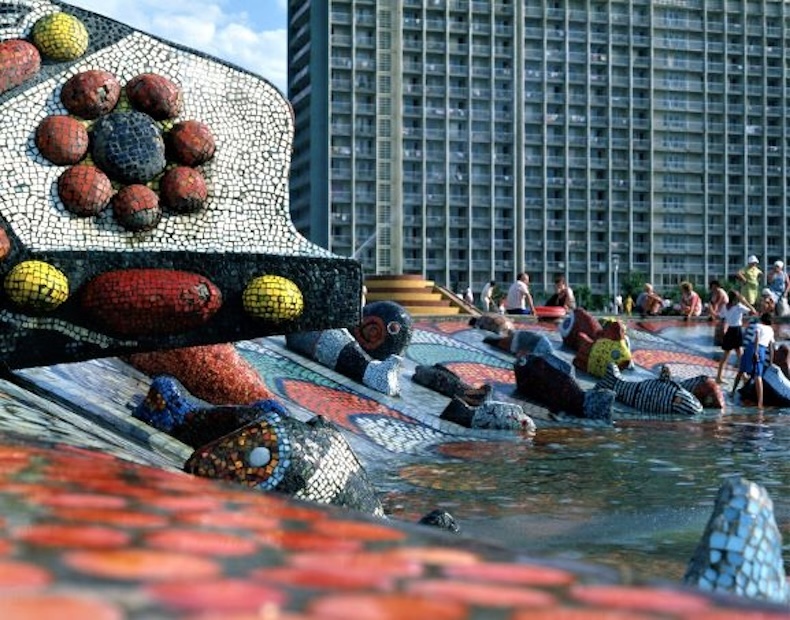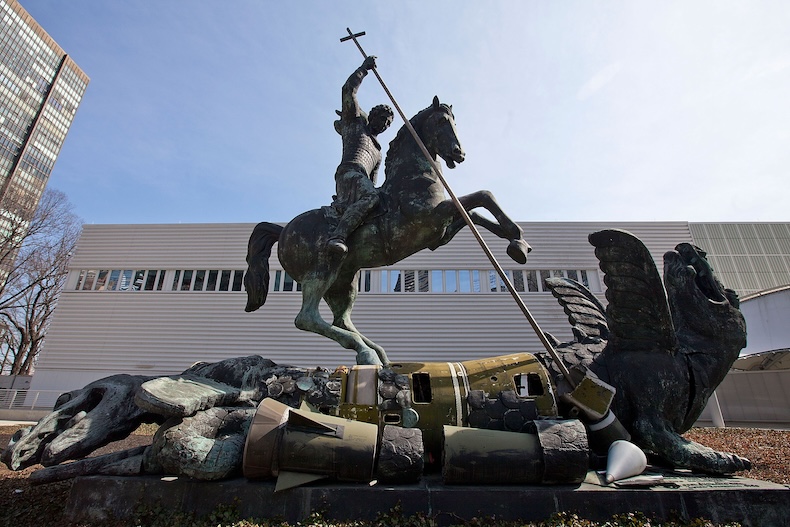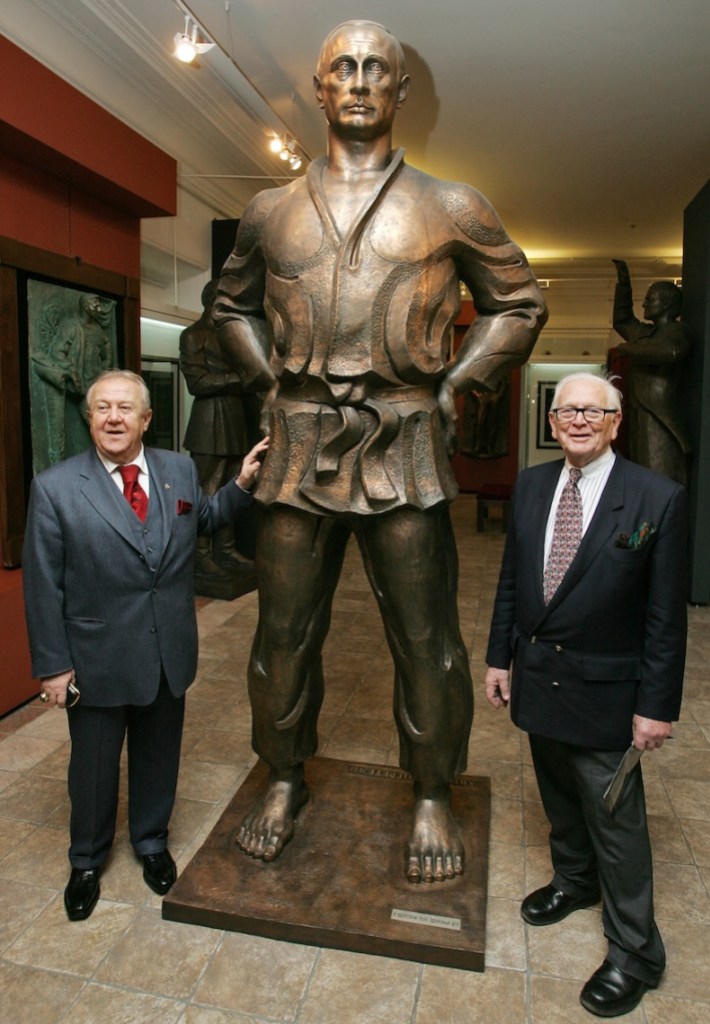The sculptor Zurab Tsereteli died last week in Moscow at the age of 91, leaving a legacy that is as colossal as it is contentious. His mammoth sculptures of historical or allegorical figures can be found all over the world and have often been criticised, but in his native Tbilisi, where he has been buried in the Pantheon of Writers and Public Figures, his work is more warmly regarded.
Born in 1934 to a poor family with an aristocratic name, Tsereteli was at first a decorative artist, covering public buildings in Georgia with vast abstract mosaics. Many of these works from the late 1960s and onwards survive, avoiding the depictions of musclebound workers and peasants that were de rigueur at the time in favour of pure abstraction. The Trade Union Cultural Centre of 1970–71 is topped by a psychedelic evocation of Georgia’s mythic past – a favourite theme – while the walls of the atrium inside are perforated with stained-glass shapes that could represent dancers. The brutalist House of Political Education (now a business centre) is dressed in a huge Pollock-like mosaic in which abstract swirls of tesserae predominate.

Monumental coral composition at Adler’s playground complex, in Russia, designed by Zurab Tsereteli in the 1990s. Photo: Albert Liberman via Getty Images
Tsereteli owed much of his success to his ability to collaborate with architects and structural engineers. In Georgia, the state-run ‘Art-Kombinat’ (art production workshop) allowed dozens of artists and craftsmen of different disciplines to work together on huge projects. The commissions rolled in. By the ’70s, Tsereteli was leading projects to design holiday resorts all around the Black Sea, designing the interiors, landscaping, lights, fountains and pools. The playground at the Adler Resort Playground Complex in Russia (1973) contains one of the most impressive mosaic sculptures ever produced with a huge concrete cnidaria at its heart, tentacles swirling in bright red tiles. Next came commissions from the Soviet Foreign Ministry – Tsereteli was chief designer for the Moscow Olympics in 1980 – and, eventually, from outside the Soviet Union. He had a talent for meeting the right people at the right time: on a trip to Paris in 1964, he met both Picasso and de Gaulle (whom he later sculpted). He came to count himself among the elite of the Soviet cultural world, where his garrulous nature, natty clothes and thick Georgian accent made him a popular figure.
Almost none of Tsereteli’s best work is known outside the former Soviet Union. For better or worse, his reputation is as the designer of megastructures, often featuring giant men standing on the prows of stylised boats, such as Birth of the New World (1992) and the statue of Peter the Great in Moscow (1997). The symbolism in these works is extremely clunky. In Good Defeats Evil (1990) at the UN building in New York, Saint George defeats a dragon made of two dismantled intercontinental ballistic missiles. A giant teardrop memorial commemorates the attacks of 11 September in New Jersey. The sculptures are pure kitsch, but kitsch blown to such pharaonic proportions is worth a second look.

Good Defeats Evil (1990) by Zurab Tsereteli depicts Saint George vanquishing a dragon lying among the fragments of a Soviet SS-20 and US Pershing missiles. It stands outside the UN building in New York. Photo: Dario Cantatore/Getty Images
Such is the case with the Columbus statue, the tallest sculpture in the Western hemisphere. It was commissioned in 1991 to mark the 500th anniversary of the discovery of America, intended as a gift from the Soviet Union to the United States. It was to stand on Roosevelt Island in the East River in New York, from where it would have dwarfed the Statue of Liberty.
By the time of the anniversary, the Soviet Union was no more, and the Roosevelt Island site had fallen through. The sculpture spent the next 30 years in limbo, as one city after another expressed interest, but baulked at the cost of what was essentially a major civil engineering project. For a time Donald Trump, who had met Tsereteli on his first and now-infamous trip to Moscow in 1987, wanted to find it another home in New York, but Columbus ended up in Arecibo, Puerto Rico, the site of his second landing in the New World in 1493.
The statue was inaugurated with great fanfare in 2016. Vasili Tsereteli, director of the modern art museum his grandfather founded, with sites in both Moscow and Tbilisi, hired a big PR agency, flew journalists out and still smarts at their sneering reviews. ‘I brought them, they all came, they all loved it. I just wanted them to write about Columbus. But nothing. They all wrote stuff they had copied from Google. About how he’s the world’s richest artist, about [former Moscow mayor Yuri] Luzhkov.’
Tsereteli had won several huge commissions in Moscow while Luzhkov was mayor, including the rebuilding of the Cathedral of Christ the Saviour and the Manezh shopping centre near the Kremlin. ‘Unfortunately for my grandfather,’ says Vasili, ‘Luzhkov was going to run in the elections against Yeltsin. A very popular guy, maybe he would be the next president.’ In his view, Yeltsin-aligned oligarchs orchestrated a hate campaign against Tsereteli’s work to discredit Luzhkov, and the gargantuan statue of Peter the Great on the Moscow River was the real turning point.

Zurab Tsereteli’s 98-metre-high statue of Peter the Great (1997) stands on the Moscow River. Photo: Imagno/Getty Images
The statue would have been controversial anyway. It is impossible to avoid the 98-metre-high figure of Peter clutching a golden scroll atop a wedding-cake-like structure of baroque ship prows. It’s also a questionable monument to put in the centre of Moscow. Peter the Great famously hated the city so much that he founded an entirely new capital. Yet Vasili Tsereteli is correct to point out that there is much nonsense said about the statue. There is, for instance, no evidence of a plot by Moscow art lovers to blow it up, nor is it simply the Columbus figure with a new head. An online poll from 2010 that deemed it the tenth ugliest structure in the world seems highly dubious.
However, Tsereteli’s closeness to the Russian elite caused some consternation in his native Georgia, 20 per cent of which has been under Russian occupation since 2008. When he died, pictures of him with the giant statue of Putin in judo robes he designed circulated on social media. The sculpture is from 2004: ‘Everyone loved Putin then’, Vasili says. Nevertheless, even among Tbilisi’s staunchly anti-Russian art scene there is respect for Tsereteli, perhaps even fondness.

Zurab Tsereteli poses next to a statue of Vladimir Putin dressed for judo, across from the fashion designer Pierre Cardin in November 2008 in Moscow. Photo: AFP Photo/Dmitry Kostyukov via Getty Images
‘He is controversial absolutely, but you can’t deny that he had a vision’, says Irena Popiashvili, dean of art at Tbilisi’s Free University and doyenne of Georgian contemporary art. ‘Today I take everyone who visits Tbilisi to the Chronicles of Georgia,’ she says, referring to an immense work that overlooks the city. The monument, which resembles Stonehenge in form, if Stonehenge were six storeys high and made of concrete, is covered in high-relief bronze panels. It depicts scenes from Georgia’s ancient history and its more recent Christian past – a daring subject to tackle in the Soviet period. It is currently the number two tourist attraction for Tbilisi according to Trip Advisor. Partly because of the cost of dismantling it, this monument, like many of the others, will last for centuries. (In Puerto Rico, Columbus has already survived a hurricane.) Whatever Tsereteli’s merits as an artist, his work will outlive his critics.














![Masterpiece [Re]discovery 2022. Photo: Ben Fisher Photography, courtesy of Masterpiece London](http://zephr.apollo-magazine.com/wp-content/uploads/2022/07/MPL2022_4263.jpg)
‘Like landscape, his objects seem to breathe’: Gordon Baldwin (1932–2025)